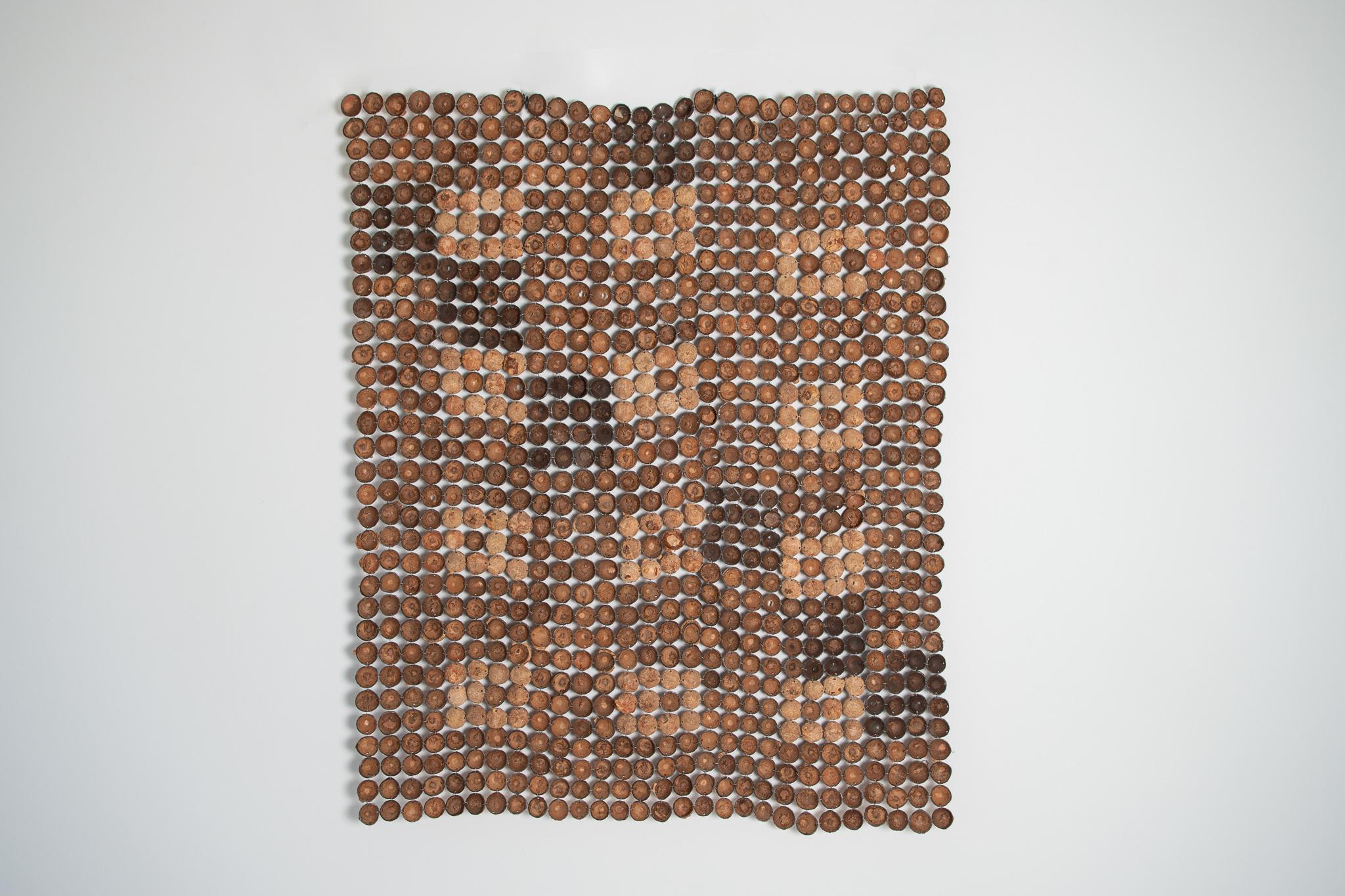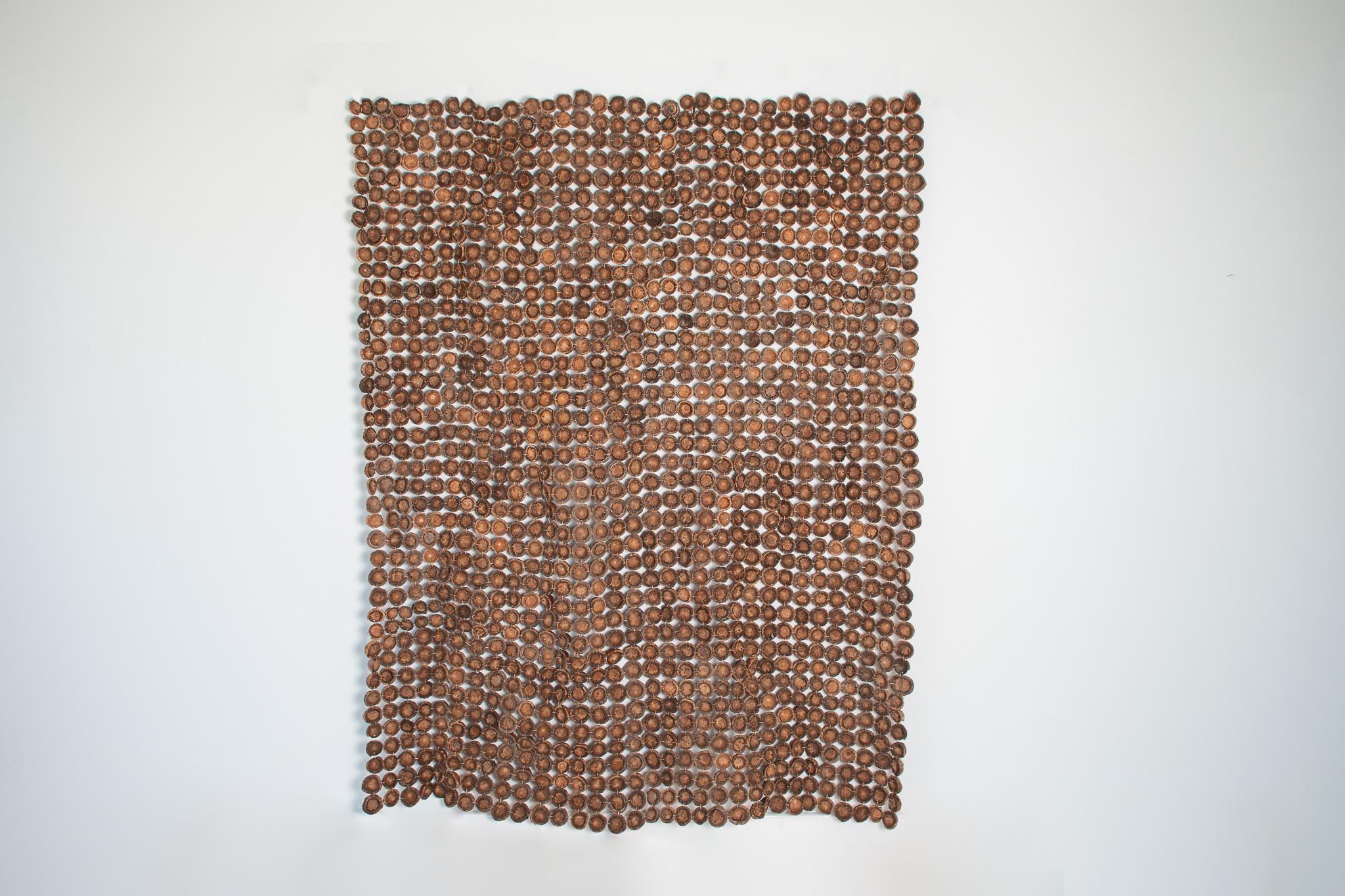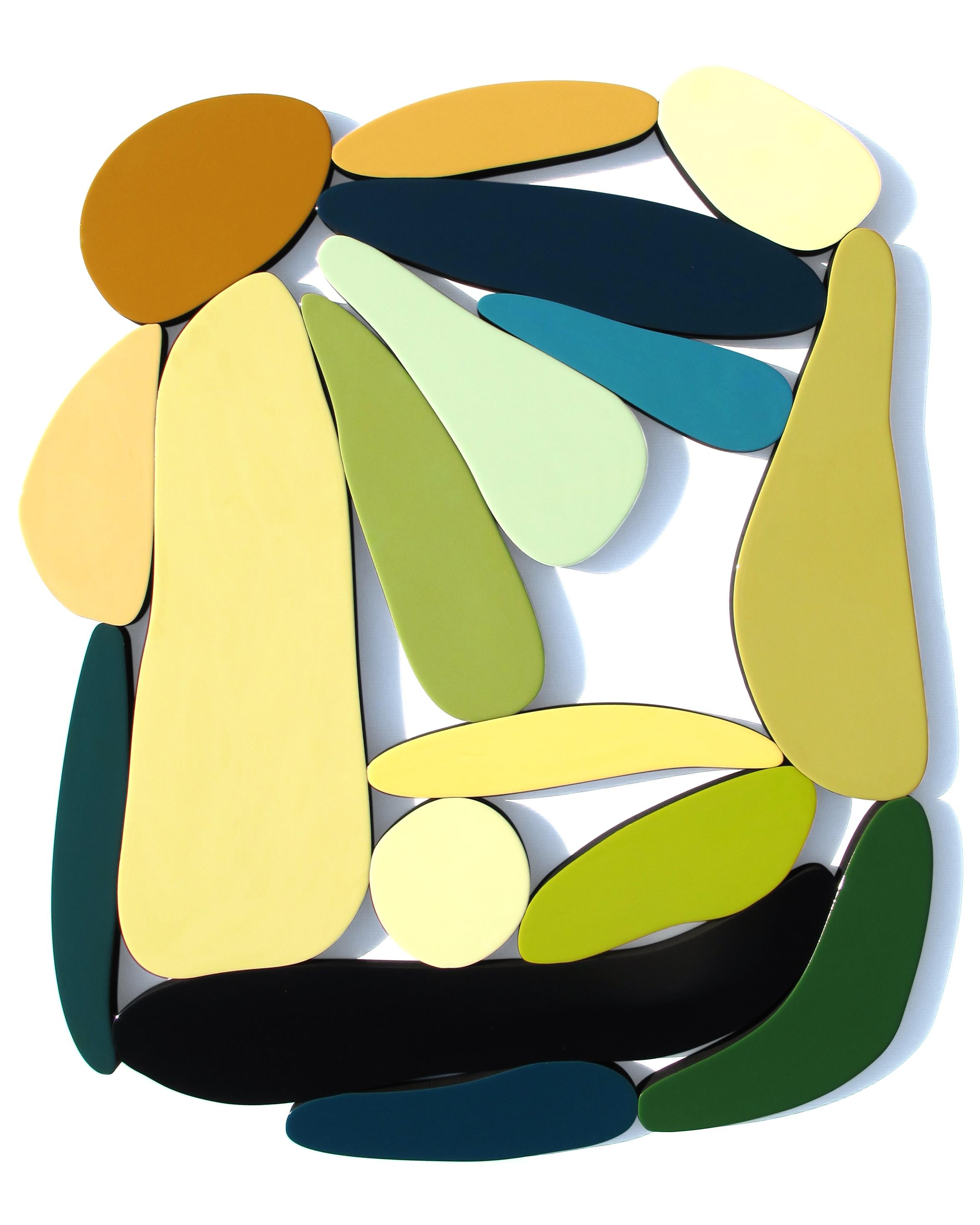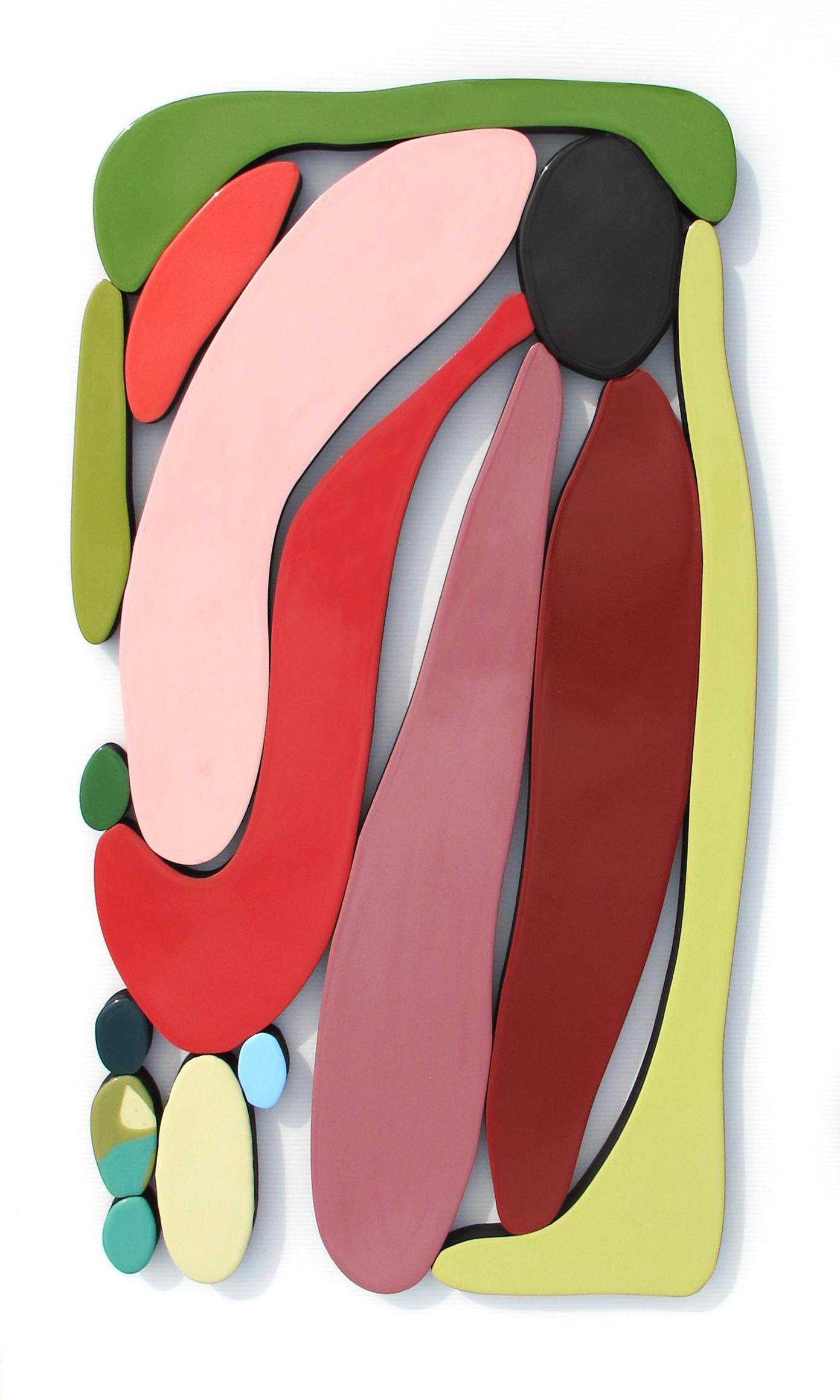Items Similar to Nurture (Imbalance), Fillipus Sheehama, Mixed media: makalani nut piths, metal
Want more images or videos?
Request additional images or videos from the seller
1 of 8
Fillipus SheehamaNurture (Imbalance), Fillipus Sheehama, Mixed media: makalani nut piths, metal2021
2021
About the Item
Nurture (Imbalance), 2021. Mixed media: makalani nut piths, plastic, bottle caps, metal
Fillipus Sheehama's latest large-scale sculptural textiles have grown out of an exploration of recycled materials and their link to overconsumption. The materials are sourced from under-maintained and largely impoverished areas of Namibia. His artistic process has evolved to incorporate organic waste materials. Indigenous makalani fruits are often used as a food source and to brew alcohol. In these works the discarded makalani piths are cut in half and hand-stitched together alongside flattened metal bottle caps and shards of animal bone. The use of these discarded materials also points to the agricultural processes that sustain subsistence farmers. Sheehama highlights issues of land (re)distribution as years of Apartheid and colonialism carved up and cut off access to much of the arable land in Namibia, leaving the majority of the population scrambling for resources. The patchwork of different materials and textures speaks to the segregation of land and people, and the need to use our natural resources and knowledge to unify for a more just and fair society.
Each artwork is both a reflection of society as well as a critique of contemporary living. He is preoccupied with ideas of wholeness, thinking about the relationship between individual and collective identity. The materials he chooses to use en masse- discarded bottle tops, plastics, old school desks- are quotidian and suggest a large group of people or a community. Despite these large communities, life remains precarious in Namibia. From his vantage point as an educator living and working in Katutura, Sheehama is constantly confronted with the fragility produced by radical economic inequality. This is reflected most intensely in the materials he chooses to work with. Sheehama draws formally from traditional Nama and Herero patchwork patterning that derives from the colonial era.
Sheehama graduated from the University of Namibia with a Bachelor of Art (Fine Art) Honours degree in 2010 and has taught Visual Arts at the John Muafangejo Arts Centre and currently lectures at the College of the Arts. Sheehama has participated in many group exhibitions locally and internationally. The artist has also had several solo exhibitions in Namibia.
- Creator:Fillipus Sheehama (1974)
- Creation Year:2021
- Dimensions:Height: 36.5 in (92.7 cm)Width: 39.38 in (100 cm)Depth: 4.53 in (11.5 cm)
- Medium:
- Movement & Style:
- Period:
- Condition:
- Gallery Location:Windhoek, NA
- Reference Number:1stDibs: LU150628692222
About the Seller
5.0
Vetted Seller
These experienced sellers undergo a comprehensive evaluation by our team of in-house experts.
Established in 2017
1stDibs seller since 2021
22 sales on 1stDibs
- ShippingRetrieving quote...Ships From: Windhoek, Namibia
- Return PolicyA return for this item may be initiated within 14 days of delivery.
More From This SellerView All
- Dominance, Fillipus Sheehama, Mixed media: makalani nut piths, metal, plasticBy Fillipus SheehamaLocated in Windhoek, NADominance, 2021. Mixed Media: Makalani nut piths, plastic and metal Fillipus Sheehama's latest large-scale sculptural textiles have grown out of an exploration of recycled materials and their link to overconsumption. The materials are sourced from under-maintained and largely impoverished areas of Namibia. His artistic process has evolved to incorporate organic waste materials. Indigenous makalani fruits are often used as a food source and to brew alcohol. In these works the discarded makalani piths are cut in half and hand-stitched together alongside flattened metal bottle caps and shards of animal bone. The use of these discarded materials also points to the agricultural processes that sustain subsistence farmers. Sheehama highlights issues of land (re)distribution as years of Apartheid and colonialism carved up and cut off access to much of the arable land in Namibia, leaving the majority of the population scrambling for resources. The patchwork of different materials and textures speaks to the segregation of land and people, and the need to use our natural resources and knowledge to unify for a more just and fair society. Each artwork is both a reflection of society as well as a critique of contemporary living. He is preoccupied with ideas of wholeness, thinking about the relationship between individual and collective identity. The materials he chooses to use en masse- discarded bottle tops, plastics, old school desks...Category
2010s Abstract Mixed Media
MaterialsWire
- Rural Transformation, Fillipus Sheehama, Mixed media: makalani nut piths, metalBy Fillipus SheehamaLocated in Windhoek, NARural Transformation, 2021. Mixed Media: Makalani nut piths and wire Fillipus Sheehama's latest large-scale sculptural textiles have grown out of an exploration of recycled material...Category
2010s Abstract Mixed Media
MaterialsWire
- Elephant in the Room, Fillipus Sheehama, Mixed media: makalani nut piths, metalBy Fillipus SheehamaLocated in Windhoek, NAElephant in the Room, 2020. Mixed Media: Makalani nut piths and wire Fillipus Sheehama's latest large-scale sculptural textiles have grown out of...Category
2010s Abstract Mixed Media
MaterialsWire
- Old Monster, Fillipus Sheehama, mixed media, organic materials, bone, makalaniBy Fillipus SheehamaLocated in Windhoek, NAOld Monster, 2020. Mixed media: makalani nut piths, animal bone and wire Namibian mixed media artist Fillipus Sheehama often constructs artworks using recycled and found materials which he uses to explore issues relating to social and economic inequality. Sheehama’s work is grounded in observation. Each artwork is both a reflection of society as well as a critique of contemporary living. He is preoccupied with ideas of wholeness, thinking about the relationship between individual and collective identity. The materials he chooses to use en masse- discarded bottle tops, plastics, old school desks...Category
2010s Contemporary Mixed Media
MaterialsWire, Metal
- Reclaimed freedom of speech 2, Elisia Nghidishange, wire, plaster, fabricBy Elisia NghidishangeLocated in Windhoek, NAReclaimed freedom of speech 2, 2020. Mixed media Elisia Nghidishange was born in Eenhana in northern Namibia. This printmaker, sculptor and mixed me...Category
21st Century and Contemporary Contemporary More Art
MaterialsWire
- Reclaimed freedom of speech 1, Elisia Nghidishange, plaster, fabric, wireBy Elisia NghidishangeLocated in Windhoek, NAReclaimed freedom of speech 1, 2020. Mixed media Elisia Nghidishange was born in Eenhana in northern Namibia. This printmaker, sculptor and mixed me...Category
21st Century and Contemporary More Art
MaterialsWire
You May Also Like
- Klari Reis, Perennial, Mixed media and epoxy on woodBy Klari ReisLocated in London, GBMixed media and epoxy on wood 114.3 x 91.4 cm 45 x 36 in. ------------ Klari Reis uses the tools and techniques of science in her creative process, constant...Category
2010s Abstract More Art
MaterialsEpoxy Resin, Wood, Mixed Media
- Klari Reis, Organelle Sprouting, Mixed media and epoxy on woodBy Klari ReisLocated in London, GBMixed media and epoxy on wood 81.3 x 43.2 cm (approx) 32 x 17 in. (approx) ----- Klari Reis uses the tools and techniques of science in her creative process...Category
2010s Abstract More Art
MaterialsEpoxy Resin, Wood, Mixed Media
- Concentric AlignmentLocated in Dallas, TXBurnt lines, rattan & wire, on indigo dyed paperCategory
2010s Abstract Mixed Media
MaterialsWire
- Pow!By Keith YoungLocated in Kansas City, MOKeith Young Pow! Collage on Canvas; Rubber, Glue, Wood, Cotton Canvas Year: 2022 Size: 12.25x11.5x3in Signed by hand COA provided Ready to hang Ref.: 924802-1134 -------------------...Category
2010s Contemporary Mixed Media
MaterialsWire
- Texas Teal and Tan Woven Fiber Art Tapestry with Copper and Wood AccentsLocated in Houston, TXTeal and tan woven fiber art tapestry by Texas artist Romeo Reyna. The piece features a central diamond shape with copper accents and painted wooden st...Category
1990s Abstract Mixed Media
MaterialsCopper
- Holocaust Remembrance Logo Pin and PendantBy Judy ChicagoLocated in New York, NYJudy Chicago Logo Pin and Pendant, 1993 Enameled pin with pendant loop in original presentation box 2 1/2 × 2 1/2 × 1/5 inches Judy Chicago's incised name and date on the verso Comes in original presentation gift box Poignant enameled Holocaust Project Logo pin & pendant based on the logo designed by Judy Chicago for the Holocaust Project: From Darkness into Light More about pioneering artist Judy Chicago Judy Chicago (born Judith Sylvia Cohen; July 20, 1939) is an American feminist artist, art educator, and writer known for her large collaborative art installation pieces about birth and creation images, which examine the role of women in history and culture. During the 1970s, Chicago founded the first feminist art program in the United States at California State University, Fresno (formerly Fresno State College) which acted as a catalyst for feminist art and art education during the 1970s. Her inclusion in hundreds of publications in various areas of the world showcases her influence in the worldwide art community. Additionally, many of her books have been published in other countries, making her work more accessible to international readers. Chicago's work incorporates a variety of artistic skills, such as needlework, counterbalanced with skills such as welding and pyrotechnics. Chicago's most well known work is The Dinner Party, which is permanently installed in the Elizabeth A. Sackler Center for Feminist Art at the Brooklyn Museum. The Dinner Party celebrates the accomplishments of women throughout history and is widely regarded as the first epic feminist artwork. Other notable art projects by Chicago include International Honor Quilt, Birth Project, Powerplay, and The Holocaust Project. She is represented by Jessica Silverman...Category
1990s Abstract Geometric Mixed Media
MaterialsMetal, Enamel
Recently Viewed
View AllMore Ways To Browse
Food Mixed Media
Bottle Cap
Bottle Capper
Used Bottle Caps
Used Bottle Cap
Metal Patchwork
Organic Patchwork
Colonial Artwork
Plastic Recycled Art
Old Alcohol
John Muafangejo
Alcohol Bottles
City Prints
Photo Print
Lithograph Vintage Art Prints Vintage Art Prints
Lithograph Vintage Art Prints
Hand Signed Print
Photography Series





